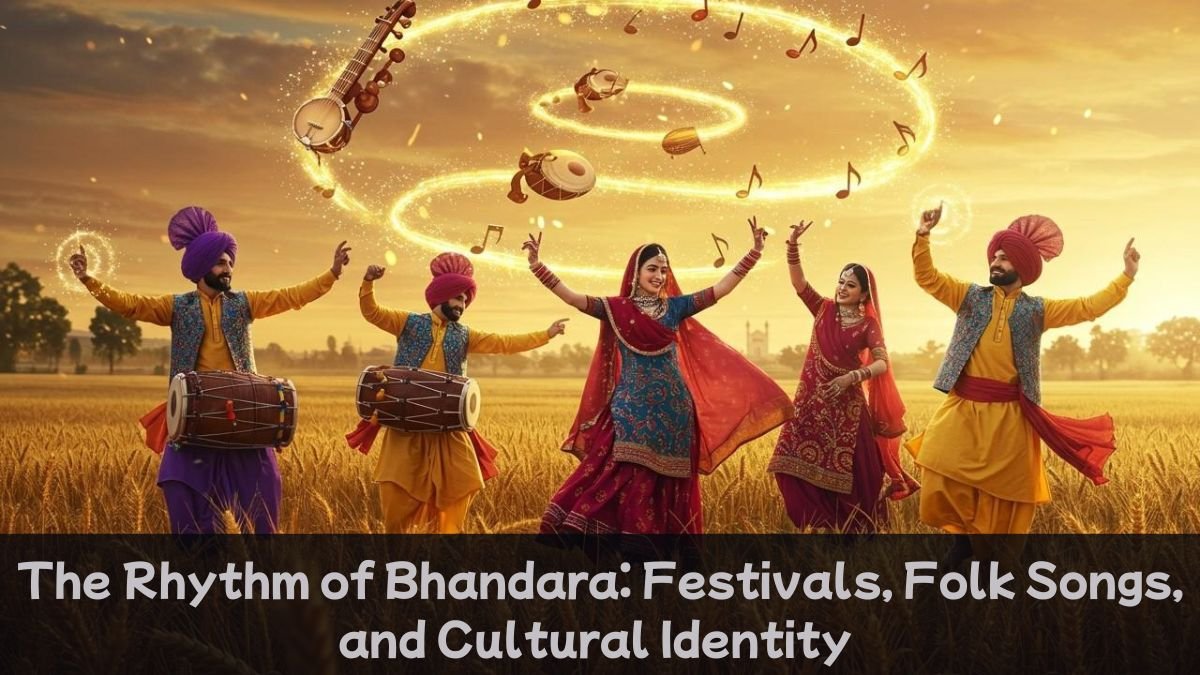Bhandara district finds its place on the east side of Maharashtra and has been commonly referred to as the Rice Bowl but we cannot define it only to be fertile land much more so can paddy cultivation be discussed so much. Bhandara is an active cultural geography whose frontier of culture includes each street, village and home with their own cultural heritage. Not just history books, but festivals, folk songs, and local traditions are enough to feel the cultural pulse of this place.
This article will take you on a journey of folk tunes, traditional festivals, and the cultural soul of the people of Bhandara, where emotions, customs, and music come together to create a wonderful folk-image.
Cultural Foundation of Bhandara – Traditions Connected to the Soil
The culture of Bhandara resides in the villages, resonates in the soil of the fields and is reflected in the composition of folk songs. Every festival, every ritual here is a worship of nature and labor. Be it a post-harvest festival or the celebration of welcoming the first shower of rain – every occasion is celebrated by the people here with song, dance, and collective gaiety.
Festivals: Festive moments of rural life
The festivals celebrated in Bhandara are not just religious rituals but are a symbol of social unity and collective participation.
Pola:
This festival is dedicated to bulls. Farmers decorate and worship the bulls, their true companions in the fields. Bulls dressed in colourful clothes pass through the streets of the villages to the tune of folk songs and drums and cards – this scene brings alive the real culture of Bhandara.
Shiva Jayanti and Ganeshotsav:
Shivaji Maharaj’s birth anniversary is celebrated with great pomp in Bhandara district. Speeches, tableaux, and folk dramas are held in schools. During Ganeshotsav, the entire area reverberates with traditional dance and bhajan-kirtan.
Navratri and Dussehra:
During Navratri, the combination of Garba and folk dance is worth watching. The younger generation dances all night long wearing traditional attire. On the day of Dussehra, along with the burning of Ravana, Ramlila is staged by local artists.
Folk songs: A glimpse of life in words
The music of Bhandaara is not just entertainment, it is an expression of the feelings, struggles and joys of the people. The folk songs sung here have been passed on from generation to generation as an oral tradition.
Ovi songs:
These songs are mainly sung by women during household chores like grinding, weaving, or on wedding occasions. Their lyrics are full of realities and emotions of life.
Wedding songs:
Traditional songs like ‘Suggi’, ‘Gauri’, and ‘Bhondla’ are sung in Bhandaara weddings, in which a group of women sing in rhythm to the beats of the dholak.
Songs of Mahar and Gond tribes:
The tribal culture here has a different color. Their lifestyle, relationship with nature and faith in gods and goddesses are expressed through folk songs. Traditional musical instruments like dhol, tasha and ‘tuil’ are used in their songs.
Dance and folk drama: A priceless treasure of visual arts
Folk dance and drama performances are also an important part of the cultural identity in Bhandara. Especially traditional forms like ‘Bharud’, ‘Jogwa’ and ‘Tamasha’ strengthen the cultural identity here.
In ‘Jogwa’, artists play the role of goddess and present devotional songs.
‘Tamasha’, which gives a social message along with entertainment, is still very popular in rural fairs.
Cultural fairs: A confluence of festivals
Fairs are held throughout the year in Bhandara district, where not only religious activities but also cultural presentations take place.
- ‘Ramdoh Mela’,
- ‘Sargaon Devi Jatra’,
‘Shegaon Yatra’ – on these occasions folk artists come from far and wide, and mesmerize the audience with their singing, dance and drama.
Young generation and cultural heritage
Even though the wave of modernity is reaching the villages, the young generation of Bhandara is now returning to its roots. Events like ‘Folk art competitions’, ‘Culture week’ and ‘Annual dance-song festival’ in schools and colleges are connecting the new generation to this heritage.
Role of women: Protectors of tradition
The women of Bhandara have not only preserved the culture, but have also played an important role in passing it on to the new generation. Songs sung in homes, traditions of festivals and folk dances – everything is alive through women.
Harmony and coexistence in the culture of Bhandara
People of all castes and religions celebrate festivals together in the cultural diversity here. Be it Eid or Holi, Christmas or Diwali – social participation is seen in every festival. This coexistence is the cultural strength of this region.
Conservation of cultural heritage: challenges and efforts
Today, when traditional arts are gradually being left behind in the digital age, many local organizations, NGOs and educational institutions in Bhandara are trying to keep this culture alive.
- “Folk music training” is being given in local schools.
- Programs like “Gram Sanskriti Mahotsav” are providing a platform to rural talents.
The cultural conservation programs run by the Zilla Parishad are also noteworthy.
The way forward: cultural tourism and global identity
This cultural heartbeat of Bhandara is no longer just local. Now the state government and the tourism department are planning to take this heritage forward in the form of “cultural tourism”. If it is given the right direction, Bhandara will create its own identity on the cultural map of not only Maharashtra but the whole of India.
Conclusion:
The cultural story of Bhandara is not confined to a book, it is alive – in songs, in festivals, and in the smiles of the people. Every rhythm, every tune, and every colour is deeply connected to this soil. “The Rhythm of Bhandara” is not just a title, but the soul of this district – a soul that beats, sings and connects people even with time.
